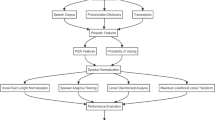Abstract
The goal of this work is to show the influence of accented speech on state-of-the-art speech-to-text (S2T) systems. In the current study, Assamese accented Hindi-English (AAHE) code-switched speech samples and Native Hindi-English (NHE) code-switched speech samples are subjected to four commercial S2T systems. The results of this study found that the word error rate averaged across the four systems is found to be 27.33% and 38.35% for the NHE and AAHE groups, respectively. This performance gap is mainly attributed to substitution errors. On further analysis, it was found that those errors resulted from the distinct phonetic and phonological properties of the Assamese language. Thus, there is a scope for accent adaptation even in concurrent S2T systems supporting Indian languages.
Access this chapter
Tax calculation will be finalised at checkout
Purchases are for personal use only
Similar content being viewed by others
References
Amazon Transcribe: Speech to Text - AWS. https://aws.amazon.com/transcribe. Accessed 14 Mar 2022
Bates, D., Mächler, M., Bolker, B., Walker, S.: Fitting linear mixed-effects models using LME4. J. Stat. Softw. 67(1), 1–48 (2015). https://doi.org/10.18637/jss.v067.i01
Diwan, A., et al.: Multilingual and code-switching ASR challenges for low resource Indian languages. In: Proceedings of Interspeech (2021)
Google Cloud: Speech-to-Text: Automatic Speech Recognition. https://cloud.google.com/speech-to-text. Accessed 04 Mar 2022
IBM Watson: Watson Speech to Text. https://www.ibm.com/cloud/watson-speech-to-text. Accessed 09 Mar 2022
Mennen, I.: Phonological and phonetic influences in non-native intonation. Trends Linguist. Stud. Monogr. 186, 53 (2007)
Microsoft Azure: Speech-to-Text. https://azure.microsoft.com/en-us/services/cognitive-services/speech-to-text. Accessed 01 Mar 2022
Mishra, S., Mishra, A.: Linguistic Interference from Hindi in Indian English. Int. J. Stud. Engl. Langu. Lit. 4(1), 29–38 (2016)
Office of the Registrar & General Census Commissioner, India: C-17 population by bilingualism and trilingualism (2011). https://censusindia.gov.in/2011census/C-17.html. Accessed 24 Mar 2022
Office of the Registrar General & Census Commissioner, India: Family-wise grouping of scheduled and non-scheduled languages (2011). https://censusindia.gov.in/2011Census/Language-2011/Statement-9.pdf. Accessed 24 Mar 2022
R Core Team: R: A Language and Environment for Statistical Computing. R Foundation for Statistical Computing, Vienna, Austria (2019). https://www.R-project.org/
Rasier, L., Hiligsmann, P.: Prosodic transfer from L1 to L2. Theoretical and methodological issues. Nouveaux cahiers de linguistique française (New Noteb. French Linguist.) 28, 41–66 (2007)
Seide, F., Li, G., Yu, D.: Conversational speech transcription using context-dependent deep neural networks. In: Proceedings of Twelfth Annual Conference of the International Speech Communication Association (2011)
Tomokiyo, L.M.: Lexical and acoustic modeling of non-native speech in LVSCR. In: Proceedings of Sixth International Conference on Spoken Language Processing (2000)
Vu, N.T., Wang, Y., Klose, M., Mihaylova, Z., Schultz, T.: Improving ASR performance on non-native speech using multilingual and crosslingual information. In: Proceedings of Fifteenth Annual Conference of the International Speech Communication Association (2014)
Wiltshire, C., Sarmah, P.: Voicing contrasts in the stops of Indian English produced by Assamese speakers. Proc. Meet. Acoust. 42(1), 060003 (2020)
Wiltshire, C.R.: The “Indian English’’ of Tibeto-Burman language speakers. Engl. World Wide 26(3), 275–300 (2005)
Wiltshire, C.R.: Uniformity and Variability in the Indian English Accent. Elements in World Englishes. Cambridge University Press (2020). https://doi.org/10.1017/9781108913768
Author information
Authors and Affiliations
Corresponding author
Editor information
Editors and Affiliations
Rights and permissions
Copyright information
© 2022 Springer Nature Switzerland AG
About this paper
Cite this paper
Chakraborty, J., Sinha, R., Sarmah, P. (2022). Influence of Accented Speech in Automatic Speech Recognition: A Case Study on Assamese L1 Speakers Speaking Code Switched Hindi-English. In: Prasanna, S.R.M., Karpov, A., Samudravijaya, K., Agrawal, S.S. (eds) Speech and Computer. SPECOM 2022. Lecture Notes in Computer Science(), vol 13721. Springer, Cham. https://doi.org/10.1007/978-3-031-20980-2_9
Download citation
DOI: https://doi.org/10.1007/978-3-031-20980-2_9
Published:
Publisher Name: Springer, Cham
Print ISBN: 978-3-031-20979-6
Online ISBN: 978-3-031-20980-2
eBook Packages: Computer ScienceComputer Science (R0)




